See a travel solution in Pistoia:
Autumn Flavours & Golf - Chestnuts in Pistoia
Located at the foot of the Appennine moutains, around 30km (20 miles) away from Florence, Lucca and Pisa, Pistoia is a city full of art yet it remains a hidden little gem for many people. This makes it all the more surprising for the casual visitor who stumbles upon a smaller Florence with no river but full of charm and the warmth that one no longer finds in big cities.
The city was founded by the Romans in the 2nd century BCE, as a place to support and supply provisions for the army fighting the Ligurians, even though it is very likely that an Etruscan settlement already existed in the area as shown by archaeological findings.
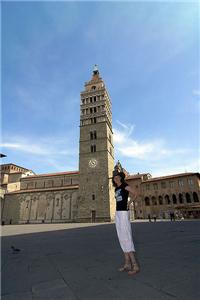
After the city was completely destroyed by the Ostrogoths, it was reconstructed and experienced its greatest period of splendor under the Longobard kingdom.
During the Middle Ages and until the early 900s the city became an important centre of politics and trade under the rule of several leading noble families. In fact, it was one of these powerful families that was behind the creation of the first cultural circles. At the time, Pistoia was known for its banking and financial services, even becoming a point of reference in Europe.
In 1351, the city fell under the control of Florence which governed it until the unification of Italy. Following the plague in 1300, which cut the population in half, a third boundary wall was built, complete with towers and ramparts as well as four gates providing entry points into the city.
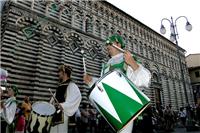
Spending a holiday in this beautiful city will also give you a chance to explore the surroundings areas and to find yourself in the midst of nature where it still reigns supreme. You'll easily fall under the spell of the stunning Pistoia's mountain with its forests of beech trees, firs and chestnut trees which gradually transforms into a gentle slope covered with olive trees.
The city centre is a well-fortified medieval complex, from its walls, still intact in some parts, down to its centre where the magnificent Piazza del Duomo is located. It appears both austere and majestic, almost magically concealed from the many little streets that have kept their medieval aura even though they now house elegant shops and jewelry stores.
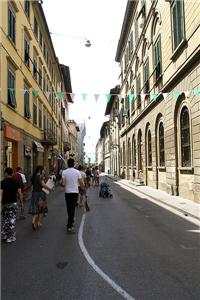
Hidden away in a recessed area of the square, there is a gothic baptistery with the striking green and white decor typical of the period. Facing this building is the Duomo, also known as the Cathedral of San Zeno, with its triple loggia structure, its elegant 14th century portico and green and white marble striped decorations. Handsome sculptures are elegantly displayed inside the Duomo, including in particular the stunning baptismal font designed by Benedetto da Maiano.
In the nave on the right side of the cathedral, you can admire one of the most precious pieces of silver in Italy: the Alter of Saint Jacob, weighing almost a ton and made up of 628 figures sculpted in high-relief. Next to the cathedral, the Palazzo del Comune is an amazing and impressive edifice built in the 13th century, a particularly prosperous period, for the magistrates of the city and which still houses the municipal administration. Across from the Palazzo is the splendid Palazzo del Tribunale and a few steps away, the Piazza della Sala, the site of the ancient marketplace and, to this day, a traditional fruit and vegetable market can be found there. Don't miss out on the chance to visit the stall of an old lady who sells herbs "that wash away fear".
The shops around this area have kept their original charm with their wooden doors, vaultings decorated with tile and their many tucked away niches. Plus, a visit to the bakery, cheese shop or butcher shop will definitely make you savor the different flavors and smells of Tuscany's many culinary traditions. You can then always rest at the Piazza della Sala at one of its many reputable restaurants or wine bars that offer both traditional dishes and ones prepared with a modern, tasteful spin by famous, innovative chefs.
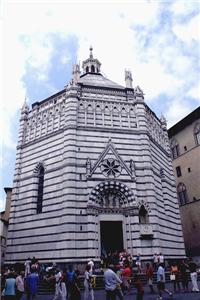
Other sights include the amazing number of historical palazzos of artistic significance which belonged at one time to the noble families but which have been since reconverted for other uses although some are still private residences even today. There are also the many Roman and gothic churches found throughout the city, the small alleyways, the wrought iron streetlights and little squares to see along the way, all of which contribute to giving the city its singular and very evocative atmosphere. The Ospedale del Ceppo, which is still the town hospital, dates back to 1200. The striking frieze decorating its glazed terracotta façade is the work of Luca della Robbia and represents perhaps his most spectacular creation using this technique.
Pistoia even has a fortress, originally erected for the Medicis, which during summer is now used as an outdoor cinema.
Access to the city is through one of four gates: Porta Lucchese, Porta Carratica, Porta San Marco and Porta Al Borgo. Whichever one you choose as an entry point, you'll immediately find yourself in a small medieval town full of fascinating historical attractions but where you can also enjoy yourself shopping, tasting the local specialties or just soaking up the atmosphere and taking advantage of the wonderful Tuscan weather.
The via Francigena that goes from Canterbury all the way to Rome is a pilgrimage route traveled on foot as a way of doing penitence (pilgrims often had to cover 25km a day) and obtaining purification of the soul and expiation of their sins. The pilgrims traveled in groups carrying their symbols: a key for Saint Peter's in Rome, the shell for Santiago de Compostela and the cross for Jerusalem.
The most important medieval pilgrimage routes between the west and northwestern Europe and the holy city of Rome intersected with Pistoia either directly or indirectly. The Knights of the Tau set up a hospital in this town for curing pilgrims (which today houses a museum dedicated to the artist Marino Marini) and often the pilgrims took a detour in their route or stopped in Pistoia to acquire an indulgence which was tied in with the visiting of different historical buildings.
The importance of the Via Francigena for Pistoia can be seen in the fact that the patron saint of the city is none other than San Jacopo or Saint Jacob or Sant Iago, the saint who immediately brings to mind the town of Santiago de Compostela, and that a shell, symbolic marker of the Way of Saint Jacob, can be found affixed to the front of the cathedral.
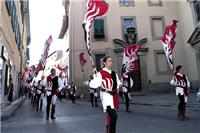
In July, Pistoia celebrates the festival of "la Giostra dell'Orso" (or Joust of the Bear), an ancient tournament dating back to around 1200, which is held in the Piazza del Duomo in honor of San Jacopo. Yet, it wasn't until 1514 that there was much information on how the competition should unfold. The event was actually a horserace covering a great deal of the city as well as a joust, with the winner being awarded the "palio", a richly decorated piece of red cloth to be placed on the altar of San Jacopo as an offering. In any case, the tradition was so popular with the townsmen that it has been held almost every year for centuries, except in the case of famine or an epidemic. The other exception was when World War I broke out after which the festival was not held again until 1947, thanks to a group of students who wanted to put the sad times of the war behind them. It was at this first reprisal that the course became a straight one, starting from the Palazzo Comunale and required striking at the head of a bear made out of paper mache.
Nowadays, the Giostra dell'Orso is held in between the countless other artistic and musical events which take place in July in Pistoia.